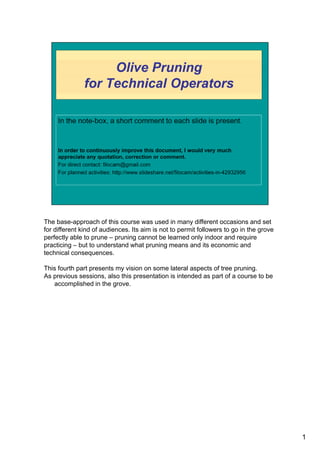Olive pruning 4 li.ppt
- 1. The base-approach of this course was used in many different occasions and set for different kind of audiences. Its aim is not to permit followers to go in the grove perfectly able to prune â pruning cannot be learned only indoor and require practicing â but to understand what pruning means and its economic and technical consequences. This fourth part presents my vision on some lateral aspects of tree pruning. As previous sessions, also this presentation is intended as part of a course to be accomplished in the grove. 1
- 2. 2
- 3. Participants are invited to answer and motivate their statements. A discussion will follow. In order to detect the most suitable time, it is important to go back to session 1 and consider that pruning is to help the grower rather than to face any actual botany or physiology need. What are the issues to consider? 3
- 4. Participants are invited to discuss what are months trees growth more. 4
- 5. Normally, there are two vegetative peaks per year. The observation of the growth of a series of non fruiting plants shows a peak in fall. For fruiting plants, during this season, most of energy is allocated to fruitsetting and ripening. 5
- 6. Although heavy pruning suits some specific aims, its routinely use implies a waste of energy, time and money. 6
- 7. Mechanical pruning is already used for a number of crops as citrus and vineyard. Due to the introduction of new training systems and the shortage of skilled workers, there is need for improvement in pruning capacity and efficiency. The mechanisation solution for large olive groves must be âin continuousâ. 7
- 8. 20 years ago the âin continuousâ mechanical pruning solution was studied. It consisted in an inclined edging. The tree would keep its vertical growth and progressively fill the canopy. This would require a manual intervention (every three years) 8
- 9. A specific pruning schedule was identified as the most performant 9
- 10. Results were encouraging in terms of results in the field as well as for the savings. 10
- 11. See: Camerini, F., Bartolozzi, F., Vergari, G. and Fontanazza, G. 1999. ANALYSIS OF THE EFFECTS OF TEN YEARS OF MECHANICAL PRUNING ON THE YIELD AND CERTAIN MORPHOLOGICAL INDEXES IN AN OLIVE ORCHARD. Acta Hort. (ISHS) 474:203-208 http://www.actahort.org/books/474/474_40.htm 11
- 12. This led to design a multipurpose machine convertible into a harvester or a pruner. 12
- 13. Low vigor varieties were the most suitable for this new management system. 13
- 14. 14
- 15. Reshaping is a direct cost and leads to a temporary loss in production capacity. It must be done only whether a substantial saving in carrying out field practices is expected. 15
- 16. 16
- 17. Something can be done to deplete the stored energy in the branches that will be cut in order to reduce the losses. 17
- 18. New branches will appear while the old one is still productive. 18
- 19. 19
- 20. 20
- 21. The old branch can be cut during harvest. 21
- 22. 22
- 23. The traditional system means: Danger of fires; Waste of organic matter; Waste of time. No advantage for the grove. 23
- 24. In sandy and stony soils the incorporation of lignin residuals and leaves carries an improvement of fertility. There is no drawback in the phytosanitary area (disease or pest). 24
- 25. 25

























